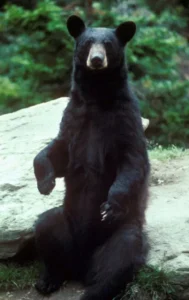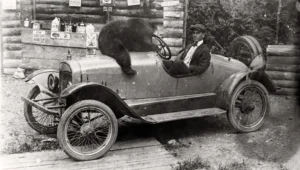calsfoundation@cals.org
When Fact Checkers Attack
 On September 3, 2025, a man named Vernon Patton was attacked by a black bear in Franklin County, an attack that ultimately proved fatal. An Arkansas Times article on the subject speculated that this attack “may be the state’s first since before the Civil War.” This was based upon a statement made by Keith Stephens, the chief of communications for the Arkansas Game and Fish Commission, who said that he had been on the job for twenty-five years and could not remember a bear attack happening during his tenure but that he did know of some articles describing such from the 1850s.
On September 3, 2025, a man named Vernon Patton was attacked by a black bear in Franklin County, an attack that ultimately proved fatal. An Arkansas Times article on the subject speculated that this attack “may be the state’s first since before the Civil War.” This was based upon a statement made by Keith Stephens, the chief of communications for the Arkansas Game and Fish Commission, who said that he had been on the job for twenty-five years and could not remember a bear attack happening during his tenure but that he did know of some articles describing such from the 1850s.
Nothing sets off the CALS Encyclopedia of Arkansas’s staff historian and fact checker Mike Polston like sweeping conclusions based upon fallible memories. So he went digging and, soon enough, had compiled accounts of a number of bear attacks throughout Arkansas history. Yes, in 1852, a sixteen-year-old boy named Alden Rose was “devoured” by a bear in Pulaski County, but that was far from being the only one. Before Polston finally gave it a rest, he found documented attacks occurring in 1892, 1902, 1942, 1998, 1999, and 2006. We assembled all the information and added a concluding paragraph to the EOA entry on black bears.
One of the surprising difficulties in researching bear attacks using keyword searches in digitized newspapers was that the phrase “bear attack” was often used to describe the actions of the stock market, as per a January 24, 1902, report in the Arkansas Gazette headlined: “Prices Go Down in Grains: The Result of a Sharp Bear Attack on Corn.” In fact, searching for the phrase “bear attack” brings up more stories about market speculation than it does about violent bruins.

Sometimes, though, these newspaper stories raised questions of their own. The previous fatal bear attack in Arkansas may have been (absent any contradictory evidence) one that occurred in May 1892 at Mountain Home. The Arkansas Democrat report on the event opens thusly: “Mrs. Mary Carter, a widow, with a small family of children, is a raving maniac, as the result of a raid upon her little cabin by a half starved black bear, in which two of her children lost their lives and one half devoured before assistance arrived.” Not to be too grisly (not grizzly) about the matter, but how many children died? One would think that being “half devoured” in 1892 in Mountain Home was to be as good as dead, so is the phrase “half devoured” an adequate description of the child’s injuries, or was it newspaper hyperbole used to describe someone who maybe suffered a few bites?
More research would be needed to clarify the situation. Our interest, however, wasn’t in producing an authoritative list of such attacks and their details—rather, we just wanted to develop a good sampling of these events throughout the years. And maybe we helped to clarify matters for the public. A follow-up report by the Times mentioned the EOA’s findings, as did a report in the Arkansas Democrat-Gazette.
Of course, we don’t want to do to bears what Jaws did to sharks, sparking a killing spree. Our goal was simply historical accuracy. But it can’t hurt the world to know that, though you may snuggle down with a teddy bear each night, bears in the wild are potentially dangerous creatures that are best left alone.
By Guy Lancaster, editor of the CALS Encyclopedia of Arkansas




